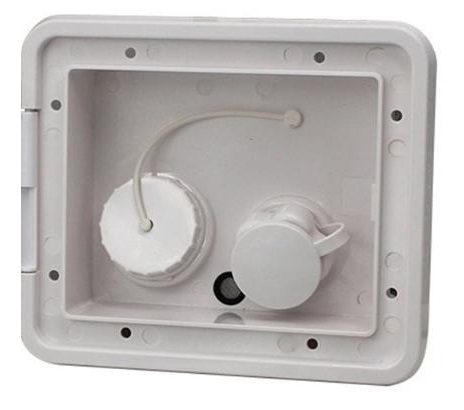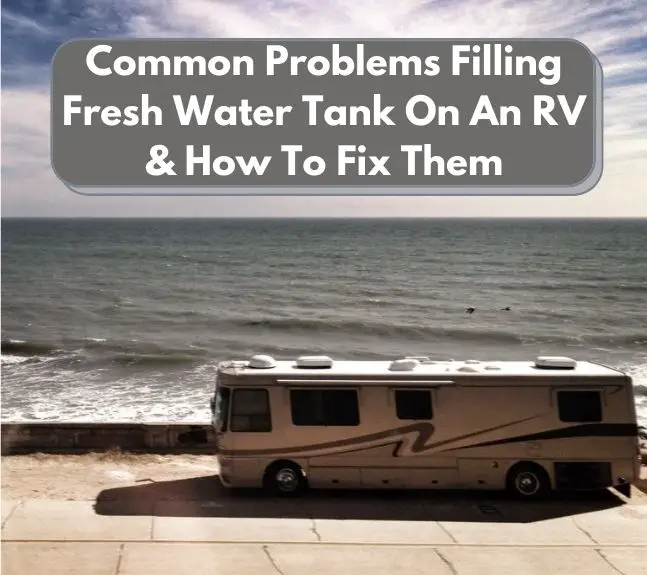Sometimes you may experience a few problems filling fresh water tank on RV which can be a hassle, especially if you plan on dry camping for extended periods of time. Of course you need plenty of potable water and to make sure your RV’s fresh water tank is as full as possible before your trip. If you’re noticing that your RV fresh water tank is filling slowly or having other issues, not to worry – we’ve put together this easy guide to help.
Main Problems Filling Fresh Water Tank on RV

RV Water Tank Filling Slowly
Some RV water tanks can back up while filling them, making it take absolutely forever for you to get your tanks full so you can finally hit the road.
Some RV guides will tell you to fill the tanks slowly with the water bib turned to the low volume setting.
Note that while you can do this, it’s going to take a long time, and that simply doesn’t work for most of us!
That doesn’t mean you can just turn the water on full blast and hope for the best, though.
Take a look at the most common problems with filling RV fresh water tanks and how to fix them below.
Your Winterizing Valves May Be On
This is a super easy fix but can prevent your RV water tanks from filling.
Check to make sure that your winterizing valves on your RV are in the non-winterized position.
Additionally, check your air vent hose or fill lines to make sure they don’t have any shutoff valves that are closed on them. It’s rare that these hoses will have shutoff valves, but they do exist.
Water Intake Problems
You could have an issue with the design of your RV’s fresh water intake, such as:
Using a fill line that is not wide enough in diameter: using too narrow of a fill line will slow down the flow of water, making your RV fresh water tank take longer to fill.
Restrictions in the fill line: if there are any clogs, bends, kinks, or other problems with your fill line it is going to slow down the fresh tank filling process.
Not enough slope between the fill line and the tank: if the fill line has any type of upward slope it is going to take significantly longer to fill your tank.
Vent Line Problems
When water enters your RV fresh water tank, the air needs to be let out (aka vented) to make room for the water.
Vent lines are skinnier than your fill line and don’t allow the air to get out quickly enough to allow a lot of water to enter the tank at once quickly.
Here are some common issues with vent lines causing problems filling fresh water tank on RV:
Water is coming in too fast: if your vent line can’t keep up with the amount of air being displaced by water, the water will come back out of the fill line, spilling water everywhere. If this is the case then you need to reduce the flow of water from the source so that the vent can keep up with it.
Vent is clogged or dirty: There is a vent cover on the outside of your RV where the fill holes are. If this filter is dirty or has debris stuck in it, that is reducing the flow of air moving out of your fresh water tank, which will cause backflow issues from your fill line and will make it take longer for your RV’s fresh water tank to fill up.
Vent line bent or damaged: Although it’s rare, it could be that your vent line could be kinked or obstructed in some way. Visually inspect it and replace the vent line if needed to resume normal operation.
Damage To Water Tank
If you force water into your RV’s fresh water tank faster than the tank can vent the air out, you run the risk of expanding your tank and possibly breaking the straps that hold the tank to your RV.
Additionally, you could cause the tank to rupture or damage the framing around the tank.
Be careful and don’t go beyond your fill rate limits when trying to resolve any problems with filling the fresh water tank on your RV.
How To Fix Problems Filling Fresh Water Tank On RV
If you’ve troubleshooted your issue using the methods outlined above and are still having problems, you can try these solutions to help you fill your RV fresh water tanks faster:
Use A Water Bandit
A great option you have is to repurpose an adapter like the Water Bandit.

These devices are designed to allow you to hook up a hose to a water source that either doesn’t have threads or is damaged, but in this case you can actually reverse the use and connect it to the end of your hose using a dual FHT hose adapter.
After you connect the Water Bandit to your hose, simply put it in the onboard RV fresh water tank fill hole, turn the water source on, and you should see your RV fresh water tanks fill much more quickly.
Try A Water Tank Filler
Water tank filler devices like the Secure-Fill lock on to your RV fresh water tank’s intake hole for a hands-free fill and also have a shutoff valve built-in.

These devices reduce back pressure and help the tank fill much more quickly and also feature built-in flow control to prevent RV fresh water tank pressurization.
Simply attach the Secure-Fill to a water hose, twist and lock it in place to your RV fresh water fill spouts, and you’re good to go.
Problems Filling RV Water Tank: Wrapping Things Up
We hope this guide helped you solve issues with a slow filling water tank on RV or filling the water tank in your camper.
Were there any other remedies you tried? Let us know in the comments below.
While you’re here, check out our other helpful RV repair guides:
- What to do if your RV water pump keeps running
- How to perform RV toilet foot pedal repair
- Our guide to RV roof reseal cost
- What to do if your RV heater is blowing cold air
- How to fix an RV microwave not working
- Our guide to motorhome fuel pump replacement
- How to replace RV window glazing bead
- How to fix an RV toilet not holding water
- How to fix a sagging RV slide out
- Preparing for an RV one night freeze

